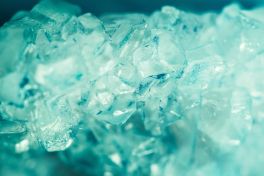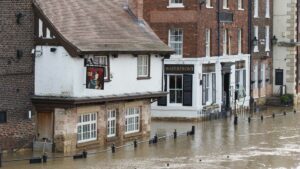
Introduction
When I was growing up, my Dad (a science teacher) occasionally asked us to ‘pass the Sodium Chloride’ at the dinner table. This was a classic (if weak) dad-joke, referring to the chemical name for common table salt. In chemistry, ‘salt’ usually refers to one or more salts – and there are many.
What are salts?
Scientists sometimes define salts as a solid chemical compound consisting of an ionic assembly of cations and anions. It’s most common (in the natural and built environment) for the cation component to be a metal such as Sodium. Other common cations are potassium and calcium (all of these are metals). Cations are free atoms with a positive charge. Also in many, but by no means all cases, the anions are an acid such as Chloride (a chlorine atom with an extra electron), AKA hydrochloric acid. Carbonates and Nitrates are also common in nature and in buildings.
The word ‘solid’ in the definition above is significant. Many salts are quite soluble in water, but as soon as they are dissolved, they are no longer technically, a salt, just some ions hanging about in a solute. A pedantic scientist (I’m looking at you, Dad) might therefore say there’s no such thing as salty water! This solubility is the root cause of a number of mechanisms that make salts cause, or contribute to problems and failures in buildings.
What salts are commonly found in buildings, and where do they come from?
Some of the most common salts to be found in buildings are calcium carbonate (the principle component of lime, cement, limestone and limescale), sodium chloride (common table or sea-salt), calcium sulphate (also known as gypsum) and various nitrates. The latter can often be found in the ground, as a result of fertilisers and urine from livestock, and are brought into the building fabric dissolved in rising damp. Gypsum is an interesting example, because it is so widely used in plasters, and the behaviour in the presence of water is one reason it’s use can be problematic in heritage/historic buildings.
What problems can they cause?
Efflorescence sounds like a late 90’s indie band, but in the context of buildings is the accumulation of salt crystals on the external or internal surfaces of buildings. This typically occurs when a wall that contains some salts becomes wet dissolving some salt; during drying, the water moves from the middle of the wall to the surface (carrying the salt with it), where it evaporates, leaving the salt behind. If a certain amount accumulates, it often appears as a white dusty mark, but in extreme cases this process can grow crystals several centimeters deep.
Salt Scouring is essentially the same process as efflorescence, but usually refers to situations where physical/mechanical damage is caused by the salt crystals themselves growing inside the pore structure of porous materials. This growth can in some cases generate sufficient internal forces to break down the materials in a similar mechanical action to spalling (freeze-thaw damage).
Observant cooks may have noticed that sea salt flakes, if left out can attract doplets of water which can even start to dissolve the crystals. This attraction of atmospheric moisture is known as hygroscopicity, and some salts are highly hygroscopic. If salts are present inside porous materials they can increase the effective hygroscopicity of that material. This can be problematic because the relationship between the moisture content of a material and the ambient relative humidity is linked by hygroscopicity; the more hygroscopic a material, the greater the moisture content at a given relative humidity. A problematic example would be where internal wall insulation (IWI) is fitted around embedded timber joists. The RH in the joists is inevitably raised to some extent by the cooling effect of the IWI cooling the masonry and joist end; if there are significant quantities of salt in the same zone, this elevated RH can cause a disproportionate increase in the moisture content of the timber, and hence the presence of salts can increase the risk of decay in such timber.
An interesting property of dissolved salts is that they increase the conductivity of the water. This has significant implications for the accuracy of resistance-type moisture probes (the inexpensive variety with pairs of pins that are pressed into the material of interest). These work by measuring the resistance between the pins, and rely on making some assumptions about the relationship between electrical conductivity and moisture content. This relationship can be significantly altered by the presence of dissolved salts which may cause such moisture meters to over-estimate the moisture content. Think carefully before pressing one of these meters into that internal layer of calcium sulphate (AKA gypsum plaster!) – what is it really telling you?
What can we do about it?
There are several methods with varying accuracy, detail and cost for measuring the salt content. Most involve removing samples, and using electrical resistance of a sample mixed with a known quantity of water, a chemical method called titration, or ion chromatography to estimate salt content.
In many situations, salts can remain present inside a dry structure with no ill effects; it is often the introduction of water that dissolves and mobilises the salts and initiates more serious problems. So an important consideration when considering action is current and future moisture levels, and wetting and drying mechanisms.
If it is really necessary to remove salts from a structure, there are various techniques involving sacrificial poultices, weakly bonded to suffering materials, but these are often time consuming and expensive. There are various products designed to prevent the movement of salts, but a variety of options should be considered for each different situation. The chemistry, physics and the intended and unintended outcomes should all be accounted for.
This brief overview barely scratches the surface of the complex and fascinating science of salts. Next time someone asks you to pass the salt, take a moment to think about the weird and wonderful substance that you sprinkle on your chips, and it’s extended family.





